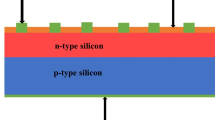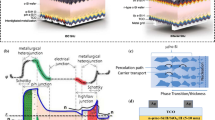Abstract
In this article, antireflection coatings (ARC) were designed for silicon-based solar cells, and their corresponding performance parameters were evaluated using TCAD (Technology computer-aided design) Sentaurus. The optical propagation and absorption of the device were considered using the transfer matrix method (TMM) and complex refractive index model. Simulation results confirmed that the reflectance for single-layer ARC (SLARC) could be reduced to zero only at a single wavelength. A much broader low-reflectance region is achieved using double-layer antireflection coatings (DLARC). This reduction in reflectance of visible light suggested better utilization of the incident solar radiation. The highest efficiency of 14.12% was achieved for DLARC (CaF2/TiO2)-based devices when compared to 10.51% for SLARC (ZnO) and 9.21% for no ARC condition. The effects on open-circuit voltage (VOC), short-circuit current density (Jsc), reflection, external quantum efficiency (EOE), and photovoltaic efficiency (\(\eta \%\)) due to different ARCs are presented in this work for silicon-based solar cells.



Similar content being viewed by others
Data availability
The datasets generated during the current study are available from the corresponding author on reasonable request.
References
G. Hashmi et al., J. Theor. Appl. Phys. 12(4), 327–334 (2018). https://doi.org/10.1007/s40094-018-0313-0
D. Kc et al., J. Electron. Mater. 50(4), 2199–2205 (2021). https://doi.org/10.1007/s11664-020-08696-5
S. Vallisree, R. Thangavel, T.R. Lenka, Mater. Res. Express (2021). https://doi.org/10.1088/2053-1591/aaf023
B. Hussain, A. Ebong, I. Ferguson, Sol. Energy Mater. Sol. Cells 139, 95–100 (2015). https://doi.org/10.1016/j.solmat.2015.03.017
X. Yan et al., Appl. Opt. 58(15), E1–E6 (2019). https://doi.org/10.1364/AO.58.0000E1
R. Sagar, A. Rao, Mater. Res. Express (2020). https://doi.org/10.1088/2053-1591/ab6ad5
K.W.A. Chee et al., Energy Rep. 4, 266–273 (2018). https://doi.org/10.1016/j.egyr.2018.02.002
R. Rathanasamy et al., Adv. Mater. Sci. Eng. 2022, 1–11 (2022). https://doi.org/10.1155/2022/9444524
A. Zahid Muhammad et al., Curr. Photovolt. Res. 8(1), 1–5 (2020)
M. Subramanian et al., Electronics 10(24), 3132 (2021)
L. Zhao et al., Opt. Mater. 121, 111594 (2021). https://doi.org/10.1016/j.optmat.2021.111594
R. Sivakumar, P. Gopalakrishnan, M.S. Abdul Razak, Astyw fyki., Pigment Resin Technol. 51(2), 171–177 (2021)
I. Kanmaz, Ü.Z. Abdullah, Int. Adv. Res. Eng. J. 5(1), 14–18 (2021)
S. Maqsood et al., J. Electron. Mater. 52(1), 165–176 (2023). https://doi.org/10.1007/s11664-022-09939-3
M. Medhat et al., Turk. J. Phys. 40, 30–39 (2016). https://doi.org/10.3906/fiz-1508-14
M.A. Zahid et al., Cryst. Res. Technol. (2022). https://doi.org/10.1002/crat.202100233
A. Diaw et al., Am. J. Energy Res. 11(1), 27–30 (2023). https://doi.org/10.12691/ajer-11-1-3
A. Sultanov, K. Nussupov, N. Beisenkhanov, Mater. Today 49, 2511–2515 (2022). https://doi.org/10.1016/j.matpr.2020.12.606
S. Saint-André et al., Sol. Energy Mater. Sol. Cells 230, 111201 (2021). https://doi.org/10.1016/j.solmat.2021.111201
X. Sun et al., Surf. Interfaces 24, 101135 (2021). https://doi.org/10.1016/j.surfin.2021.101135
M.A. Zahid et al., Appl. Sci. (2020). https://doi.org/10.3390/app10165647
K. ChandraSekharReddy et al., Solar Energy 190, 119–125 (2019). https://doi.org/10.1016/j.solener.2019.07.083
C. Ma et al., Appl. Surf. Sci. 560, 149924 (2021). https://doi.org/10.1016/j.apsusc.2021.149924
R. Huang et al., Comput. Mater. Sci. (2020). https://doi.org/10.1016/j.commatsci.2020.109600
M. Mostefaoui et al., Energy Procedia 74, 736–744 (2015). https://doi.org/10.1016/j.egypro.2015.07.809
G. Timò, L. Andreani, in 2017 IEEE 44th Photovoltaic Specialist Conference (PVSC). 2017. https://doi.org/10.1109/PVSC.2017.8521506
J.M. Siqueiros, R. Machorro, L.E. Regalado, Appl. Opt. 27(12), 2549–2553 (1988). https://doi.org/10.1364/AO.27.002549
B.S. Richards, Sol. Energy Mater. Sol. Cells 79(3), 369–390 (2003). https://doi.org/10.1016/S0927-0248(02)00473-7
J. Jung et al., J. Nanosci. Nanotechnol. 18(2), 1274–1278 (2018). https://doi.org/10.1166/jnn.2018.14928
D.F. Zambrano et al., Sol. Energy Mater. Sol. Cells (2021). https://doi.org/10.1016/j.solmat.2020.110841
L. Fanni et al., Mater. Res. Express 2(7), 075006 (2015). https://doi.org/10.1088/2053-1591/2/7/075006
M. Moayedfar, M.K. Assadi, Rev. Adv. Mater. Sci. 53(2), 187–205 (2018). https://doi.org/10.1515/rams-2018-0013
T.M. Letcher, V.M. Fthenakis, Index, in A Comprehensive Guide to Solar Energy Systems. ed. by T.M. Letcher, V.M. Fthenakis (Academic Press, Cambridge, 2018), pp.505–517
H.A. Macleod, Thin-film optical filters (CRC Press, Boca Raton, 2017). https://doi.org/10.1201/9781420033236
I.H. Malitson, Appl. Opt. 2(11), 1103–1107 (1963). https://doi.org/10.1364/AO.2.001103
A. Jolivet et al., Appl. Surf. Sci. 608, 155214 (2023). https://doi.org/10.1016/j.apsusc.2022.155214
A.J. Addie, R.A. Ismail, M.A. Mohammed, Silicon 14(18), 12485–12493 (2022). https://doi.org/10.1007/s12633-022-01948-5
R.L. Politanskyi et al., Opt. Mater. 102, 109782 (2020). https://doi.org/10.1016/j.optmat.2020.109782
Acknowledgements
We acknowledge MHRD, Govt of India, for the financial support to Anterdipan Singh in the form of PMRF fellowship and Rohan Ghosh for MSR fellowship. We also acknowledge Professor Gaurav Trivedi (EEE, IIT Guwahati) for providing access to Sentaurus TCAD.
Funding
No external funding was received for this work.
Author information
Authors and Affiliations
Contributions
AS contributed to conceptualization, methodology, simulation, writing—original draft, and editing. RG contributed to simulation, review, and editing, and PA contributed to supervision, conceptualization, and validation—review & editing.
Corresponding author
Ethics declarations
Conflict of interest
The authors declare that they have no known competing financial interests or personal relationships that could have appeared to influence the work reported in this paper.
Additional information
Publisher's Note
Springer Nature remains neutral with regard to jurisdictional claims in published maps and institutional affiliations.
Rights and permissions
Springer Nature or its licensor (e.g. a society or other partner) holds exclusive rights to this article under a publishing agreement with the author(s) or other rightsholder(s); author self-archiving of the accepted manuscript version of this article is solely governed by the terms of such publishing agreement and applicable law.
About this article
Cite this article
Singh, A., Ghosh, R. & Agarwal, P. Selection of materials and optimization of antireflection coatings for silicon solar cells using Sentaurus TCAD. J Mater Sci: Mater Electron 34, 1235 (2023). https://doi.org/10.1007/s10854-023-10612-6
Received:
Accepted:
Published:
DOI: https://doi.org/10.1007/s10854-023-10612-6




